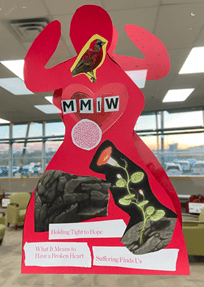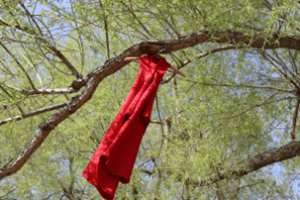During the month of May, you will see Wood Buffalo Regional Library’s lower floor windows filled with artwork that depicts a silhouette of an Indigenous woman wearing red. These decorative pieces have been completed by patrons from Wood Buffalo and is intended to raise empathy and awareness for May 5th, the National Day of Awareness for Missing & Murdered Indigenous Women, and Girls. It is also known as Red Dress Day.

Red Dress Day was inspired by Métis artist Jamie Black’s 2010 REDress Project where she hung hundreds of empty red dresses in public places to symbolize the missing or murdered Indigenous women and girls. In an interview with the Smithsonian, Black explains that the project was created to “confront people with the violence that women are experiencing, and to create a space for women to tell those stories.” Black chose red after learning it is the only color spirits can see. Black explains that “[Red] is really a calling back of the spirits of these women and allowing them a chance to be among us, and to have their voices heard through their family members and community.” This first showing in 2010 sparked a grassroots movement that quickly spread across North America and is now honored every year.

This violence against Indigenous Women, Girls, and Two-Spirit peoples stems from Canada’s lingering colonial legacy, and its devaluation of Indigenous peoples. In 2016 a national inquiry into Missing and Murdered Indigenous Women and Girls was launched to investigate the systemic causes of all forms of violence against Indigenous women and girls and to examine the underlying social, economic, cultural, institutional, and historical causes that contribute to the ongoing violence and particular vulnerabilities. In their findings, they learned that Indigenous Women represented 10% of the total missing population in Canada, and that between 1980-2014 there were 6,847 police-reported female homicide cases in Canada. Among the total number of female victims, 16% were Indigenous women. Since 1991, the number of murdered non-Indigenous women has declined. In contrast, the number of murdered Indigenous women has remained relatively stable, thus accounting for an increasing proportion of Indigenous female homicide victims. For example, in 1980, Indigenous women accounted for 9% (18) of female homicide victims, whereas in 2014, they accounted for 21% (30) of female homicide victims. The final report into the Missing and Murdered Indigenous Women and Girls can be downloaded and read online with the official website. However, if you would like to read a print version, our library has this item available in our collection.
Commemorations for May 5th vary from community to community, but generally observers wear red and meet in groups to hear speakers or hold vigils. This year the Athabasca Tribal Council, the Nistawoyou Association Friendship Center and the Regional Municipality of Wood Buffalo have partnered to organize a solidarity walk and memorial round dance to honor victims and spread awareness. Families are welcomed to bring a framed photo of their missing loved ones to be remembered at this event. To learn more about it, visit ATC’s event page.

You can join the Wood Buffalo Regional Library’s commemoration of Red Dress Day by visiting us anytime for the month of May in the seating area near the Indigenous Cultural Corner to create your own Red Dress silhouette. You are welcome to leave it for us to add to our windows, or to take the silhouette with you to display as you choose.
To learn more about the MMIWG Movement, visit this list of materials which are available to borrow with a library membership.
This day may be triggering for some people. Call 1-844-413-6649 to access an independent, national, toll-free support call line available for anyone who requires assistance, free of charge, 24/7. You can also visit the Hope for Wellness Helpline and Chat Counselling Service for mental health and crisis intervention for Indigenous people.



Add a comment to: Red Dress Day